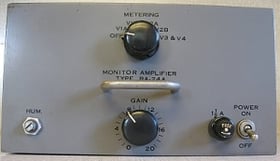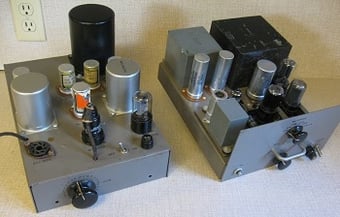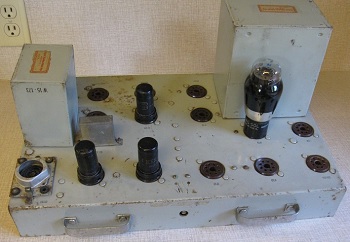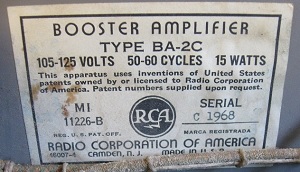The Dawn of Plug and Play | Telos Alliance
By The Telos Alliance Team on Jul 23, 2015 3:49:28 PM
 The Dawn of Plug and Play
The Dawn of Plug and Play
The advent of modular electronics was a great leap forward for broadcast maintenance. Many of us remember the Gates Solid Statesman line of consoles - the Executive, Stereo Statesman, Gatesway II, Dualux II, and Diplomat, as some of the first items of studio gear that had plug-in modules. The amplifiers, power supplies and muting control could all be swapped around, which was a great aid in isolating troubles, repair, and staying on the air.
What is not as well known is that modular broadcast audio amplifiers had been around for some time before Gates rolled out the Solid Statesman gear. This installment of Found in the Attic looks at a forgotten genre of broadcast audio gear, the modular vacuum tube amplifier, also known as... the dawn of plug and play.
Who was the first company to manufacture systems of modular audio amps? The origins are murky, but by the early 1950s, RCA broadcast catalogs had a section devoted to this product line. Similar offerings could be seen in the Gates, General Electric, and Western Electric catalogs. Power supplies, mic preamps, booster amps, line amps and monitor amps were available, along with lots of accessories.
Some of those amps had built-in power supplies, while others relied on an external supply that usually  powered several amplifiers on a rack shelf. These modular amp arrays were occasionally sighted during nickel tours of large- or medium-market stations, but rarely in small market operations.
powered several amplifiers on a rack shelf. These modular amp arrays were occasionally sighted during nickel tours of large- or medium-market stations, but rarely in small market operations.
You could usually purchase the connectors that mated with the amplifiers, make up your own wiring harnesses, and stick a couple amplifiers wherever you needed them. Of course there were rack shelves with rails on the back so you could mount connectors and put your selection of amps in an equipment rack. Blank panels and chassis were often available for those innovators who wanted to roll their own equipment.
In addition to providing connections for power (both filament and plate) and audio ins and outs, there was often a provision for remotely checking the tubes in an amplifier. Cathode current is a good indicator of emission and how much life is left in a vacuum tube. Current for each tube was sampled through a resistor, and brought out to the rear connector. In a smaller installation, engineers sometimes wired these connections out to pin jacks. Larger installations often had a rack mount tube tester.
Some were factory made, another accessory available from the manufacturer. Others were home brew, as these were simple devices. Wires from the current samples were connected to a rotary switch, whose output went to a milliammeter. Rotating the switch enabled the engineer to quickly check all the tubes and have a good estimate of remaining life. More elaborate testers had two rotary switches, one for the amplifier, the other for the tubes in the amplifier.
These amplifiers were in their prime during the days when radio and TV stations went off the air Sundays after midnight for maintenance. One of the weekly chores was logging cathode current on all the amplifier tubes, and replacing ones that were nearing the end of their life. Hopefully, this would head off any unscheduled outages due to tube failure in the following week. However, there could still be problems with filaments burning out or a tube developing internal shorts, things which weren't easily predicted.
Modular audio amps continued to be available as stations converted from vacuum tubes to solid state. Gates made rack mounts and accessories available to use the Solid Statesman modules, other companies had similar offerings. RCA also had AGC and limiter amps in their modular product line.
 Pictured is a sampling of modular amps from the attic, the earliest using octal tubes with grid caps, later ones with Noval tubes.
Pictured is a sampling of modular amps from the attic, the earliest using octal tubes with grid caps, later ones with Noval tubes.
The RCA BA-2C booster amp dates from the late 1940s. Tube lineup is a 6X5 rectifier and two type 1620 low-microphonic pentodes. It was revived in the mid-1980s and briefly used as a cue amp in an on-air studio. For want of another space, it was put on the floor under the console in a wooden enclosure with a screened in top. It doubled as a foot warmer, and was a welcome addition during the cold winter months when the studio had little or no heat.
The BA-24A monitor amp dates from the early 1960s. It uses a 5Y3 rectifier, 12AT7 input stage, 12AX7 driver and two 6V6 output tubes in push-pull.
These two RCA devices trace the evolution of electronics construction techniques. The BA-2 used point-to-point wiring, and had a rather large bus bar running around to ground components to. It made the BA-2 clutter-free and easy to work on. Connections were made by a standard Cinch-Jones plug on the back.
Coming along in the early 1960s, the BA-24A is built using a printed circuit board for the driver and push-pull output circuit, while the first stage tube is shock mounted with rubber grommets on its own little chassis. Miniaturization was the goal. While the BA-24A has a lot more circuitry than the BA-2, it is about the same size. Two much smaller connectors with gold contacts are used for interface.
The printed circuit boards on these amps were not terribly fun to work on. The heat from the 6V6s often damaged the board, and shortened the life of nearby components. Some, but not all parts could be replaced without the need to dismount the circuit board.
The third item proves that there is no upper limit on size to vintage plug and play amplifiers. Just put handles on the front and connectors on the back, and it's good to go. This monitor amp dates from 1948, and came out of a Federal Radio and Telephone console. All of the electronics for this console were mounted in shelves under the desktop.
This is a particularly massive power amp, with four 6L6 tubes in a push-pull parallel configuration. Also noteworthy are the octal sockets on the chassis for multi-section electrolytic capacitors, making replacement a snap. The octal electrolytic packaging seems not to have been available for long, and the sockets for conventional twist-lock electrolytic cans seem to be more common.
The RCA amps were discovered in the 1980s while organizing the file cabinets in the engineering office of a Boston radio station. A previous engineer had put them in the back of the drawers to prevent file folders from falling down.
Apart from the ‘80s revival of the BA-2C, the rest of these modular amps are in 'as found' condition, complete with leaky wax caps, long-dead electrolytics, and out-of-tolerance carbon resistors. All have had a cosmetic cleanup prior to the photo shoot for this article. They have been relegated to 'art object' status, and are part of the rotating display of vintage equipment throughout the house.
Telos Alliance has led the audio industry’s innovation in Broadcast Audio, Digital Mixing & Mastering, Audio Processors & Compression, Broadcast Mixing Consoles, Audio Interfaces, AoIP & VoIP for over three decades. The Telos Alliance family of products include Telos® Systems, Omnia® Audio, Axia® Audio, Linear Acoustic®, 25-Seven® Systems, Minnetonka™ Audio and Jünger Audio. Covering all ranges of Audio Applications for Radio & Television from Telos Infinity IP Intercom Systems, Jünger Audio AIXpressor Audio Processor, Omnia 11 Radio Processors, Axia Networked Quasar Broadcast Mixing Consoles and Linear Acoustic AMS Audio Quality Loudness Monitoring and 25-Seven TVC-15 Watermark Analyzer & Monitor. Telos Alliance offers audio solutions for any and every Radio, Television, Live Events, Podcast & Live Streaming Studio With Telos Alliance “Broadcast Without Limits.”
Recent Posts
Subscribe
If you love broadcast audio, you'll love Telos Alliance's newsletter. Get it delivered to your inbox by subscribing below!